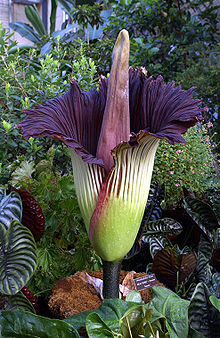- Amorphophallus titanum
-
Amorphophallus titanum 
Scientific classification Kingdom: Plantae (unranked): Angiosperms (unranked): Monocots Order: Alismatales Family: Araceae Subfamily: Aroideae Tribe: Thomsonieae Genus: Amorphophallus Species: A. titanum Binomial name Amorphophallus titanum
(Becc.) Becc. ex ArcangThe titan arum or Amorphophallus titanum (from Ancient Greek amorphos, "without form, misshapen" + phallos, "phallus", and titan, "giant" [Giant Misshapen Penis]) is a flowering plant with the largest unbranched inflorescence in the world. The titan arum's inflorescence is not as large as that of the Talipot palm, Corypha umbraculifera, but the inflorescence of the Talipot palm is branched rather than unbranched.
Due to its odor, which is reminiscent of the smell of a decomposing mammal,[1] the titan arum is characterized as a carrion flower, and is also known as the "corpse flower", or "corpse plant" (Indonesian: bunga bangkai – bunga means flower, while bangkai means corpse or cadaver). For the same reason, the title "corpse flower" is also attributed to the genus Rafflesia which, like the titan arum, grows in the rainforests of Sumatra.
Contents
Distribution
Amorphophallus titanum is endemic to western Sumatra, where it grows in openings in rainforests on limestone hills.[2] The plant is cultivated by botanic gardens and private collectors around the world.
Description
The titan arum's inflorescence can reach over 3 metres (10 ft) in height. Like the related cuckoo pint and calla lily, it consists of a fragrant spadix of flowers wrapped by a spathe, which looks like a large petal. In the case of the titan arum, the spathe is green on the outside and dark burgundy red on the inside, and deeply furrowed. The spadix is hollow and resembles a large loaf of French bread. The upper, visible portion of the spadix is covered in pollen, while its lower extremity is spangled with bright red-orange carpels. The "fragrance" of the titan arum resembles rotting meat, attracting carrion-eating beetles and Flesh Flies (family Sarcophagidae) that pollinate it. The inflorescence's deep red color and texture contribute to the illusion that the spathe is a piece of meat. During bloom, the tip of the spadix is approximately human body temperature, which helps the perfume volatilize; this heat is also believed to assist in the illusion that attracts carcass-eating insects.
Both male and female flowers grow in the same inflorescence. The female flowers open first, then a day or two following, the male flowers open. This usually prevents the flower from self-pollinating.
After the flower dies back, a single leaf, which reaches the size of a small tree, grows from the underground corm. The leaf grows on a semi-green stalk that branches into three sections at the top, each containing many leaflets. The leaf structure can reach up to 6 metres (20 ft) tall and 5 metres (16 ft) across. Each year, the old leaf dies and a new one grows in its place. When the corm has stored enough energy, it becomes dormant for about 4 months. Then, the process repeats.
The corm is the largest known, weighing around 50 kilograms (110 lb).[3] When a specimen at the Princess of Wales Conservatory, Kew Gardens, was repotted after its dormant period, the weight was recorded as 91 kilograms (200 lb).[4]
Cultivation
Open flower at United States Botanic Garden, Washington, DC, on 23 November 2005, 4 days after flowering, with the spathe half collapsed
The titan arum grows in the wild only in the equatorial rainforests of Sumatra, Indonesia. It was first scientifically described in 1878 by Italian botanist Odoardo Beccari. The plant flowers only infrequently in the wild and even more rarely when cultivated. It first flowered in cultivation at the Royal Botanic Gardens at Kew in London, in 1889, with over 100 cultivated blossoms since then. The first documented flowerings in the United States were at New York Botanical Garden in 1937 and 1939. This flowering also inspired the designation of the titan arum as the official flower of the Bronx in 1939, only to be replaced in 2000 by the day lily. The number of cultivated plants has increased in recent years, and it is not uncommon for there to be five or more flowering events in gardens around the world in a single year. The titan arum is more commonly available to the advanced gardener due to pollination techniques.
The popular name 'Titan arum' was invented by the broadcaster and naturalist Sir David Attenborough, for his BBC series 'The Private Life of Plants,' in which the flowering and pollination of the plant were filmed for the first time. Attenborough felt that constantly referring to the plant as Amorphophallus on a popular TV documentary would be inappropriate.[5]
In 2003, the tallest bloom in cultivation, some 2.74 m (8 ft 11 in) high, was achieved at the Botanical Garden of the University of Bonn in Germany. The event was acknowledged by the Guinness Book of Records.[6] On 20 October 2005, this record was broken at the botanical and zoological garden Wilhelma in Stuttgart, Germany; the bloom reached a height of 2.94 m (9 ft 6 in). The record was broken again by Louis Ricciardiello, whose specimen measured 3.1 m (10 ft 2.25 in) tall on 18 June 2010, when it was on display at Winnipesaukee Orchids in Gilford, New Hampshire, USA. This event, too, was acknowledged by Guinness World Records.[7][8]
Footnotes
- ^ "History and Botany of the Titan Arum" from the Brooklyn Botanic Garden
- ^ University of Connecticut (14 Feb 2011). "Amorphophallus titanum". http://titanarum.uconn.edu/199500115.html. Retrieved 17 February 2011.
- ^ "Titan Arum Blooming". Events. UNC Charlotte Botanical Gardens. 2007. http://gardens.uncc.edu/Titan%20Arum.htm. Retrieved 2008-10-28.[dead link]
- ^ "About titan arum Amorphophallus titanum". Information sheetO10. Royal Botanic Gardens Kew. 2006. http://www.kew.org/ksheets/pdfs/o10titanarum.pdf. Retrieved 2008-10-26.
- ^ "David Attenborough: a wild life". London: Telegraph. 2008-01-05. http://www.telegraph.co.uk/earth/main.jhtml;jsessionid=BMIDSMB4FSVSNQFIQMFCFFOAVCBQYIV0?xml=/earth/2008/01/05/eadavid105.xml&page=3. Retrieved 2008-10-26.
- ^ Botanic Garden of the University of Bonn. "Official Homepage of the Botanic Garden". http://botgart.uni-bonn.de/o_inter/engl01.html. Retrieved 2008-02-08
- ^ Tallest bloom. Guinness World Records.
- ^ Koziol, J. 2010. 'Corpse flower' makes Guinness record. Fosters, September 24, 2010.
Bibliography
- Bown, Deni (2000). Aroids: Plants of the Arum Family. Timber Press. ISBN 0-88192-485-7
- Association of Education and Research Greenhouse Newsletter, volume 15 number 1.
Gallery
See also
External links
- In depth species information from Royal Botanic Gardens, Kew
- Titan flowering (with video) at Royal Botanic Gardens, Kew
- Three Webcams of Titan plus time-lapse videos at Gustavus Adolphus College in Saint Peter, Minnesota
- 3D Photo of 2004 bloom at Walt Disney World (Requires red/cyan 3D Glasses)
- List of bloomings in the US since 1937
- How to grow a Titan Arum
- Titan Arum at the Flower Park Kagoshima of Kagoshima Prefecture, Japan (Japanese)
List of Indonesia-related topics History Timeline · Pre-colonial Indonesia (pre-1602) · Dutch East Indies (1602–1945) · Post-independence (1945–1965) · New Order (1965–1998) · Reformation (1998 to date)
Geography and
natural historyGovernment
and politicsPancasila · Constitution · President (list) · Cabinet · People's Consultative Assembly · Foreign relations · Political parties · Elections · Military · Law · Law enforcement · Human rights · LGBT rightsEconomy Companies · Communications · International rankings · Science and technology · Stock Exchange · Tourism · TransportCulture Architecture · Art · Cinema · Cuisine · Dance · Education · Figures · Heroes · Legends · Literature · Martial arts · Media · Music · Public holidays · SportDemographics National symbols Categories:- Amorphophallus
- Endemic flora of Indonesia
- National symbols of Indonesia
- Garden plants of Asia
- Flowers
Wikimedia Foundation. 2010.







